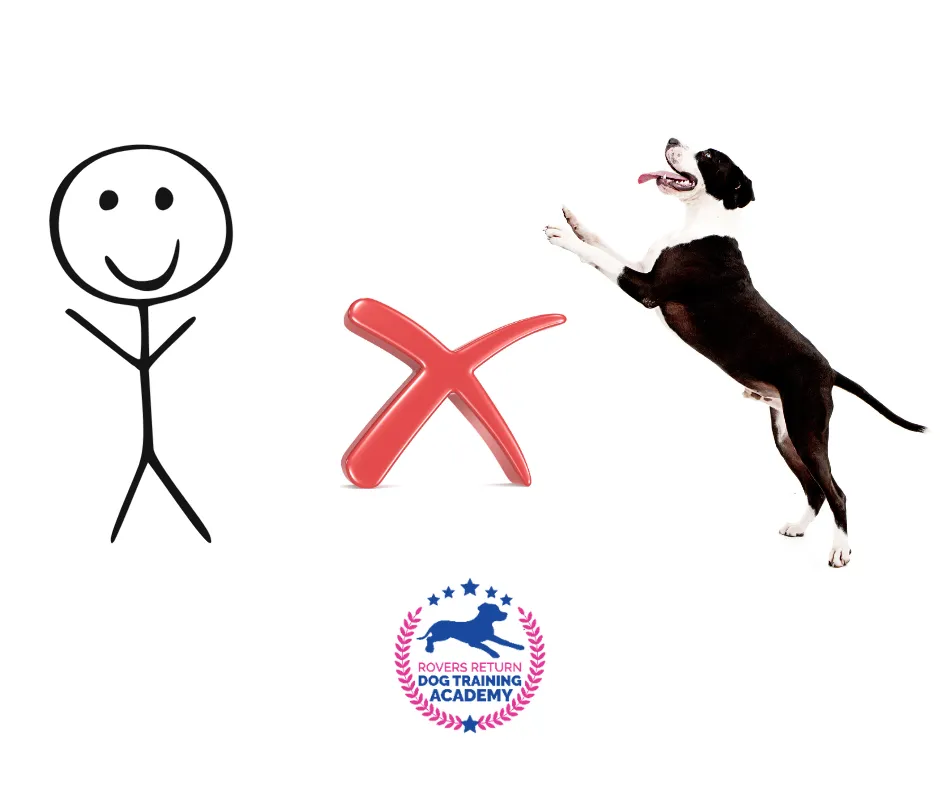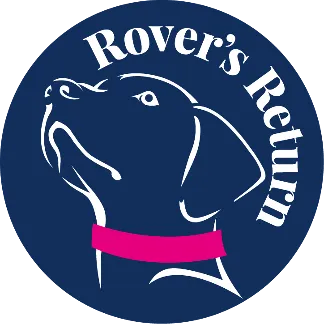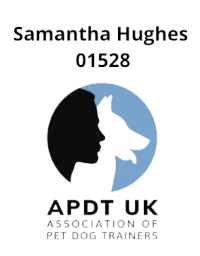Book a FREE 1:1 Assessment Call By Clicking HERE
Specialising In Dog Reactive Behviour
Accredited by APDT, ABTC and UK DOG Behaviour and Training Charter
Qualified and Experienced
Force Free Trainer and Behaviourist
Dog Training Leicestershire Educational Blogs

Seven Ways To Prevent Your Dog From Jumping Up
Seven Ways to Prevent Your Dog From Jumping Up

Jumping Up. Is it a Dog Nuisance in Leicestershire?
Understanding why dogs jump up and the importance of training are crucial aspects of preventing this behaviour. Jumping up can be a natural instinct for dogs, as it is a way for them to seek attention or show excitement.
Jumping up is self-reinforcing, which means that the act of doing it is rewarding for the dog, so they will continue to do it time and time again.
We often teach our dog to jump up. As cute little puppies, we encourage it, stroking them when they jump up. But that cute little puppy grows into a large adult dog. And it is no longer cute, or welcome. It can also be a nuisance and potentially dangerous, especially if the dog is large or jumps on children or elderly individuals.
Consistency and repetition in training are key to ensuring long-term success in preventing jumping up. In this article, we will explore various techniques and tips to help you train your dog to stop jumping up.

1. Understanding why dogs jump up and the importance of training
Understanding why dogs jump up and the importance of training are crucial aspects of preventing this behaviour. Jumping up can be a natural instinct for dogs, as it is a way for them to seek attention or show excitement. Dogs may jump up to greet their owners when they come home or to reach something they desire, such as food on a table. It is essential to remember that dogs do not jump up to assert dominance but rather to engage with their environment. Training is vital to address this behaviour because it helps dogs learn appropriate ways to interact with humans and their surroundings. By teaching them alternative behaviours, we can redirect their energy and enthusiasm in a more acceptable manner. Additionally, training can help create a bond of trust and respect between the dog and its owner, leading to a harmonious relationship.
2. Positive reinforcement training techniques to prevent jumping up
Positive reinforcement training techniques can be highly effective in teaching dogs to refrain from jumping up. Instead of punishing the dog for jumping up, which can lead to confusion and anxiety, positive reinforcement focuses on rewarding desired behaviours. One technique is to use treats or praise to reward the dog when it keeps all four paws on the ground. Timing is crucial, as marking the behaviour should be done immediately after the desired behaviour is exhibited, you then have time to give them a reward. This helps the dog make the connection between the behaviour and the reward. Consistency is key in this training approach, as the dog needs to understand that jumping up will not result in any rewards. It is also important to avoid inadvertently reinforcing the jumping behaviour by giving attention or rewards when the dog jumps up. By consistently rewarding and reinforcing the desired behaviour of keeping all four paws on the ground, dogs will gradually learn that this is the preferred way to interact with humans.
3. Teaching alternative behaviours than jumping up
Teaching alternative behaviours to jumping up is an essential part of preventing this unwanted behaviour. One effective alternative behaviour is teaching the dog to sit before being greeted. By training the dog to sit when greeting people, they learn that sitting is a more appropriate way to seek attention. This can be achieved through positive reinforcement techniques, such as offering treats or praise when the dog sits instead of jumping up. Another alternative behaviour is teaching the dog to greet people with a toy in its mouth or by offering a paw for a handshake. These behaviours redirect the dog's energy and enthusiasm in a more acceptable manner. Consistency in training is crucial, as the dog needs to understand that these alternative behaviours are the preferred way to interact with humans. With patience and practice, dogs can learn to replace the instinct to jump up with more appropriate and polite behaviours.
4. Consistency and repetition in training to prevent jumping up
Consistency and repetition are key factors in training to prevent jumping up. Dogs thrive on routine and clear expectations, so it is important to be consistent in your training approach. This means that all members of the household should be on the same page and enforce the same rules regarding jumping up. It is also essential to be consistent in the use of commands and rewards. By consistently rewarding the desired behaviour and ignoring or redirecting the jumping behaviour, dogs will quickly learn what is expected of them. Repetition is also crucial in training. Dogs learn through repetition, so it is important to practice the desired behaviours regularly. This can be done during dedicated training sessions as well as in everyday situations. The more opportunities dogs have to practice the alternative behaviours, the more likely they are to internalize and generalize them. With consistent and repetitive training, dogs can learn to break the habit of jumping up and replace it with more appropriate behaviours.
5. Tips for addressing jumping up in different situations and scenarios
Addressing jumping up in different situations and scenarios requires some additional tips and strategies. Firstly, it is important to anticipate situations where jumping up is likely to occur, such as when guests arrive or during exciting playtime. By being proactive and prepared, you can redirect your dog's behaviour before they have a chance to jump up. Secondly, teaching a solid "stay" command can be helpful in preventing jumping up. By instructing your dog to stay in a designated spot when guests arrive, you can prevent them from jumping up and instead encourage them to remain calm and composed. Additionally, it is important to provide your dog with plenty of physical and mental exercise to help reduce their excess energy, which can contribute to jumping up. Finally, consider seeking professional help from a certified dog trainer or behaviourist if you are struggling to address jumping up effectively. They can provide personalized guidance and support to help you and your dog overcome this behaviour.
6. A Calm Dog Does Not Jump Up
Promoting calmness in dogs is essential and without it, it is likely that training will fail. Promote calm behaviour through enrichment, scent work, rewarding calm behaviours, chewing and licking are both naturally calming activities that your dog will love to engage in.
Promoting calmness your dog's brain will be ready to greet visitors
7. Manage The Situation
If you leave food on the side that dogs are able to reach, or any food in areas where dogs have access to then they will probably take advantage of it.
Dogs are scavengers, This is how we domesticate them, by feeding them scraps of our food, therefore this behaviour is instinctual.
Ensure that all food is away from the dogs' reach and prevent rehearsal of the behaviour.
The same goes for people they meet outside and when visiting the home.
Put the dog into another room to prevent jumping up
Employ them in a fun activity
Ask people not to stroke your dog unless they are calmly sitting down, even if they dont mind them jumping up
Give your dog space so that they can’t practise jumping up, and have them on a lead to prevent the behaviour.
In conclusion, understanding why dogs jump up and the importance of training is crucial in preventing this behaviour. Positive reinforcement training techniques, such as rewarding desired behaviours, can be highly effective in teaching dogs to refrain from jumping up. Teaching alternative behaviours, such as sitting or offering a toy, redirects their energy in a more acceptable manner. Consistency and repetition in training are key to ensuring long-term success. By being consistent in enforcing rules and practising desired behaviours, dogs can learn what is expected of them. Addressing jumping up in different situations and scenarios requires anticipation, proactive redirection, and providing ample exercise for your dog. Seeking professional help may also be beneficial if you are struggling to address jumping up effectively. With patience, consistency, and positive reinforcement, you can train your dog to prevent jumping up and create a harmonious relationship based on trust and respect.

Highly Qualified Behaviourist
Accredited by APDT, ABTC and UK DOG Behaviour and Training Charter
Accredited Scentwork Instructor
Force Free Trainer and Behaviour
Force Free Trainer and Behaviour
Accredited Scentwork Instructor
Accredited by APDT, ABTC and UK DOG Behaviour and Training Charter
Highly Qualified Behaviourist
Contact Us
Sam: 07725 802995
You can contact us via Live Chat button at the bottom of the screen or the contact box to the right.
You can also book one of our services online using the View Dates buttons under the service you require.
© 2023 by Rovers Return Dog Trainers Academy - Force Free Dog Training Lutterworth, Broughton Astley, Leicestershire, Hinckley, Nuneaton, Stoney Stanton, South Kilworth, Ullesthorpe
Privacy Policy | Terms and Conditions | Terms and Conditions of Services | Sitemap


Facebook
Instagram
X
LinkedIn
Youtube
TikTok